Greek Diaspora History
1821 Greek War of Independence Timeline
1821 Greek War of Independence Timeline
The 1821 Greek War of Independence timeline is a series of events that ultimately led to the formation of the modern Greek state. The Greek struggle for independence however, was just that – a struggle. It was a long, drawn out conflict that gave rise to epic Greek heroes and legends, while also mourning the massacres of entire Greek populations.
As Greeks, on 25 March, we remember and acknowledge the suffering of our forefathers, who fought and died for our freedom and independence. The first step to do this is through knowledge and education.
Background context for the Greek War of Independence
To understand the events outlined in the 1821 Greek War of Independence timeline, we must first examine the situation that led to the Greek struggle for independence.
The Byzantine Empire (Eastern Roman Empire)
The majority of Greece fell to the Roman Republic in 146 BC, however although all of Greece would come to be ruled by the Romans, Greek language, culture and traditions were not suppressed but rather adopted and encouraged to thrive. This is the very reason the phrase “Rome may have conquered Greece but Greek culture has conquered Rome” exists.
Learn more about how Greek culture influenced the development of Roman civilization here.
In 330 AD, Roman Emperor Constantine moved the capital of the Empire to Constantinople, which he founded as a second Rome on the site of the Ancient Greek city of Byzantium. Due to the size of the Roman Empire and the administrative challenges this created, the Empire was split into East and West. The Western Roman Empire soon began to fall into decline and eventually fell to Germanic tribes in 476 AD.
Greek, alongside Latin, was an official language of the Roman Empire right from the beginning, however the majority of the Eastern Empire’s inhabitants only spoke Greek (due to them either being ethnically Greek or speaking the language as a result of Alexander the Great’s conquests and resulting Hellenistic Kingdoms). In the 7th Century AD, the Emperor Heraclius declared Greek the sole official language of the Eastern Roman Empire. Due to the very strong Greek linguistic, ethnic, and cultural ties to the Eastern Roman Empire, to differentiate it from the classical Latin Roman Empire, Western historians began referring to the Empire as the “Byzantine Empire” more than 100 years after its fall.
When did the Ottomans invade Greece?
The Ottomans invaded and conquered what is today part of Eastern Macedonia and Thrace in Greece around 1366, however they had already conquered Ancient Greek lands in North West Anatolia (Asia Minor) when they formed their Empire in 1300.
When did the Greek Byzantines lose Constantinople?
Constantinople was the capital of the Byzantine Empire and was a city admired by all that passed through its walls. By 1453, Constantinople was all that was left of the once grand Byzantine Empire. The Fall of Constantinople on 29 May 1453 and the fall of the Byzantine Empire is a day that continues to sadden most Greeks until this very day.
Most are not aware however, that Constantinople was not that last area to be ruled by Greek Byzantines. A small strong hold in Morea, located in the Mani Peninsula of the Peloponnese, and the Byzantine successor state – The Empire of Trebizond did not fall until 1461. Additionally, a small area on the Crimean Peninsula called the Principality of Theodoro (also known as Gothia) did not fall to the Ottomans until 1475.
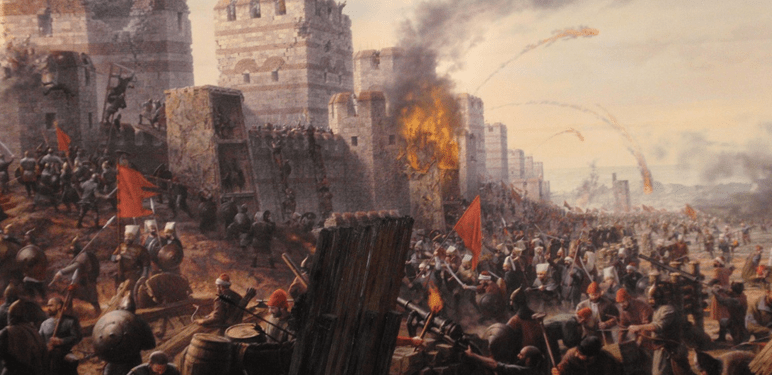
Greeks during Ottoman occupation
The Ottoman Empire organised its subjects into a form of religious class system called the “millet” system. At the top of the millet system were Muslims. Next in importance was the Orthodox Christian Rūm millet, which was often called the “Greek millet.” Although, Greeks were afforded a degree of autonomy in this system, there were a number of key disadvantages:
- Christians were not allowed to bear arms
- Christians were forced to pay a special tax called the “haradj”
- In a court of law, a Muslim’s word was always accepted over that of a Christian
- A Christian could not marry a Muslim woman, and there was a strict prohibition against renouncing Islam
- Christians who had converted to Islam and then reverted back to Christianity were punished by death
- Christians were forced to pay the Jannisary levy:
- Christian families were required to hand over to Ottoman authorities some of their most intelligent and handsome male children to convert to Islam and serve as elite troops known as “jannisaries”
- This levy remained in place until the end of the 17th century
- In most cases, these young men were so indoctrinated with hate for non-Muslims that they would regularly pillage and rape Christian villages
These key disadvantages, along with regular Christian persecutions, contributed to a sense of distain and discontent from Greeks and other Christian subjects towards their rulers. A factor that contributed to a lack of large scale revolts in the first couple of hundred years of Ottoman rule was that the Ottomans guaranteed the Christian Orthodox Church religious autonomy, so long as the clergy prevented their parishes from revolting. In the revolts that followed there are a number of high profile instances were Bishops and even Patriarchs were executed for failing to uphold this arrangement.
Timeline of attempted Greek revolts prior to the successful 1821 Greek War of Independence
1611 – Epirus Revolt
The Epirus Revolt, also known as the uprising of Dionisios Skylosophos, was one of the earliest large scale organised Greek revolts against the Ottoman Empire. Led by the Greek Orthodox bishop Dionysios Skylosophos, rebels attacked the city of Ioannina in Epirus on 10 September, 1611 and were initially successful in their attempts to liberate the city. The following day however, the uprising was brutally suppressed and the ringleaders were executed.
1770 – Orlov Revolt
The Orlov Revolt was a Russian sponsored Greek revolt and was part of Catherine the Great’s “Greek Plan”.
Click here to find out more facts about Catherine the Great and the Greek Plan.
Greeks were promised 10,000 soldiers and military equipment from Russia to help with the revolt. The Russian plan was to distract the Ottomans with an Orthodox Christian Revolution in Southern Greece, while the Russians advanced from the Black Sea. The Orlov Revolt broke out in the Peloponnese and later also in Crete in February 1770. Russian Admiral and commander of the Imperial Russian Navy, Alexey Orlov arrived in the Mani Peninsula. Another Orlov brother, Fyodor Orlov, arrived in Morea to coordinate Greek rebels.
When the Russian war fleet arrived, Greeks were disappointed to see only four ships and a few hundred soldiers, with inadequate arms and supplies. As the Russians failed to bring the forces they promised, the revolt was soon crushed. Greek reinforcements from Macedonia were halted by the Ottomans in their descent to Morea and were therefore unable to assist the Greek and Russian revolutionaries. Muslim Albanian mercenaries hired by the Ottomans during the failed Orlov Revolt remained in the Peloponnese and periodically launched reprisals against the Greeks.
Up until this point, Greeks had looked to Russia, as their Christian Orthodox brothers, to liberate them from Ottoman rule. However, the broken promise, which ultimately led to the failure of the Orlov Revolt led to a distrust of Russia by many Greeks.
Timeline of the 1821 Greek War of Independence including significant events and battles
1814 – The founding of Filiki Eteria
The Filiki Eteria (Society of Friends) was a secret organisation founded in 1814 in Odessa, Russia (now in Ukraine) with the purpose of overthrowing Ottoman rule in Greece and establishing an independent Greek state.
The Society’s members were mainly educated, young Phanariot Greeks from Constantinople and the Russian Empire, but also included many other prominent Greeks such as politicians, military leaders, academics, and Orthodox Christian leaders. The three founding members were Nikolaos Skoufas from Arta, Emmanuil Xanthos from Patmos, and Athanasios Tsakalov from Ioannina. Not long after, Panagiotis Anagnostopoulos from Andritsaina became the forth member.

1817 – Ioannis Kapodistrias rejects Filiki Eteria leadership
In 1817, the head of Filiki Eteria relocated from Odessa to Constantinople. The founders felt it would be wise to find a well-known Greek personality to lead the secret organisation. They had a meeting with Ioannis Kapodistrias to offer him the leadership, who was at the time Minister of Foreign Affairs of Russia. Kapodistrias rejected the offer.
Learn more about Ioannis Kapodistrias.
1820 – Alexandros Ypsilantis becomes leader of Filiki Eteria
Alexandros Ypsilantis was a member of a prominent Phanariot Greek family, a prince of the Danubian Principalities and a senior officer of the Imperial Russian cavalry during the Napoleonic Wars. In 1820, Ypsilantis was offered the leadership of Filiki Eteria and accepted in April the same year.

Upon assuming the leadership, he immediately began preparations for a revolution and set up a military unit, which he named the Sacred Band (in honour of the Ancient Sacred Band of Thebes). Constantinople was initially proposed as the location to initiate the Greek War of Independence. The decision was made however, to start from both Morea in the Peloponnese and the Danubian Principalities of Moldavia and Wallachia.
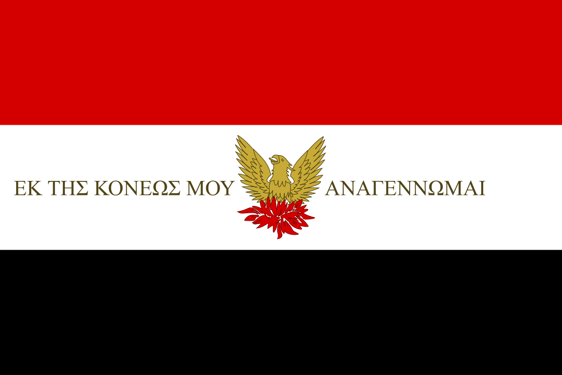
1821 – The Greek War of Independence is declared
The existence of Filiki Eteria was leaked to the Ottomans and Alexandros Ypsilantis was forced to rush the outbreak of the Greek Revolution. On 22 February, 1821, accompanied by several other Greek officers in Russian service, Ypsilantis crossed the Prut River at Sculeni and entered into the two Principalities. Two days later, at Iasi, Ypsilantis issued a proclamation, announcing that he had “the support of a great power,” meaning Russia. Ypsilantis gambled on Orthodox Russia to intervene should the Ottomans invade Wallachia and Moldavia to quell the rebellion.
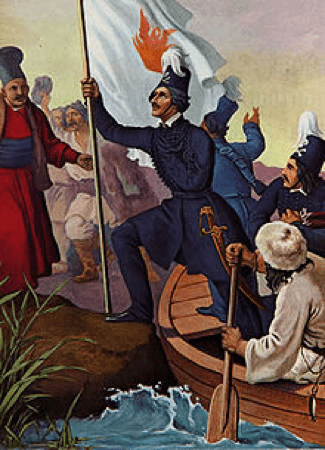
Although, Ypsilantis raised the flag of his Secret Band in battle, the first commonly acknowledged flag in the Greek War of Independence timeline was raised on 13 March, 1821 by Laskarina Bouboulina on the island of Spetses. Bouboulina was an extremely wealthy ship owner, who had the misfortune of being widowed not once, but twice.

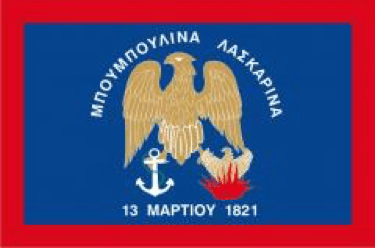
The Maniots, descendants of the Spartans on the Mani peninsula in Peloponnese, declared war on the Ottomans on 17 March, 1821 in Areopoli. 2,000 Maniots led by Petros Mavromichalis advanced on the Messenian town of Kalamata the very same day. In Kalamata, Greek revolutionary forces under the commands of Theodoros Kolokotronis, Nikitaras, Papaflessas, and Petros Mavromichalis all joined. Greek revolutionary forces captured Kalamata on 23 March. Elsewhere, Greek revolutionary forces besieged the town of Kalavryta in Achaia on 21 March.
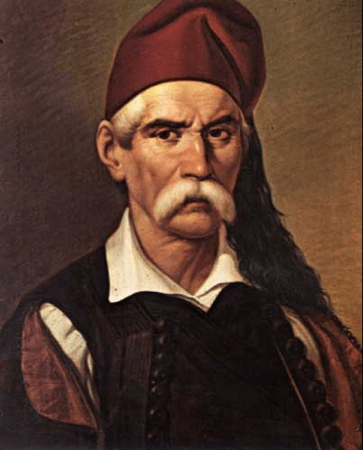
25 March, 1821 is the date celebrated as the declaration of the Greek Revolution and is often attributed as the start of the Greek War of Independence timeline. The event referenced for this date is Metropolitan Germanos of Patras, who raised the Revolutionary banner with its cross in the Monastery of Agia Lavra, near Kalavryta. A number of historians however, doubt the accuracy of this event or that it even occurred!
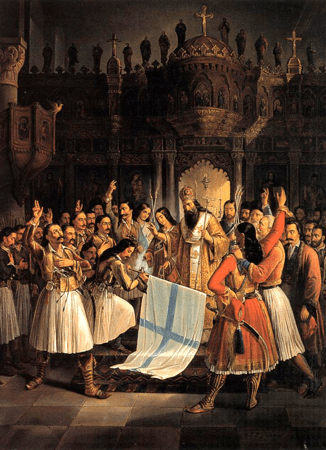
Athanasios Nikolaos Massavetas, better known as Athanasios Diakos, was a Greek Orthodox monk who later became a deacon and a klepht. During the Greek Revolution, Diakos was a revolutionary fighter, rising to prominence in Eastern Central Greece. He bravely liberated the cities of Livadia, Thebes, and Atalanta. At the Battle of Alamana, were Diakos was greatly outnumbered, he was wounded and taken prisoner. What followed is both incredibly gruesome but also what would elevate Diakos to legendary status. Offered to become an officer in the Ottoman army if he converted from Christianity to Islam, legend has it Diakos refused by replying “I was born a Greek, I shall die a Greek” (“Γραικός γεννήθηκα, Γραικός θε να πεθάνω”). Athanasios Diakos was impaled and roasted to death on 23 April, 1821.
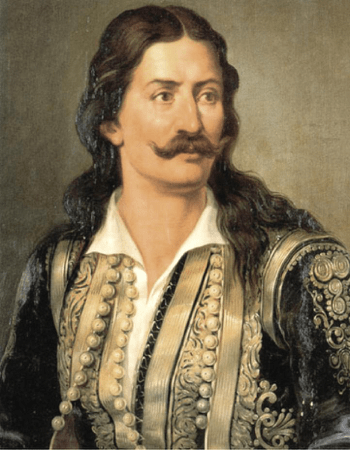
On 8 May, 1821, Chieftain and Greek revolutionary fighter Odysseas Androutsos were trapped in Gravia Inn. The Greeks rebelled the initial attach on the inn, which compelled the Ottomans to call for cannons to blow up the inn. Androutsos and his men somehow managed to escape and flee before the cannons arrived. The battle was a success for the Greeks, with more than 300 Ottomans killed and 600 wounded, while the Greeks lost only six revolutionary fighters on that day.
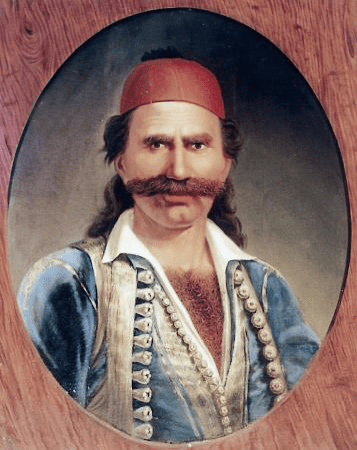
An army of 12,000 Ottomans approached Kalamata with the objective of retaking the city on 12 May, 1821. With a mere 700 men, Theodoros Kolokotronis intercepted and attacked the Ottomans. After 23 hours of fighting, in the early hours of 13 May, 1821, the Ottomans hastily retreated, leaving behind valuable weapons. This was a very significant Greek victory in the Greek War of Independence timeline. Not only did the Ottomans lose 300 men and a further 500 wounded, while the Greeks only sustained two fatalities, but it was also the first time the Greeks fought in an organised formation with sound battle strategy.
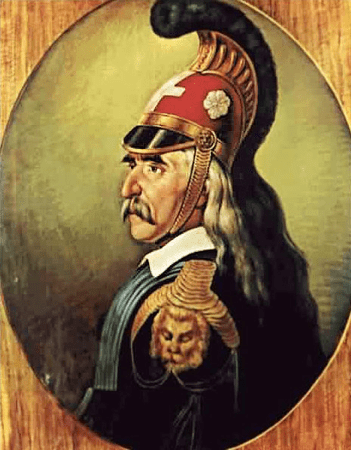
15,000 Greek troops laid a siege on the strategic city of Tripolitsa that lasted months. On the morning of 23 September, 1821, 50 Greek revolutionaries took advantage of an unguarded canon tower gate. They breached the walls by climbing on each other’s shoulders, opening the gate, and raising the Greek flag. Seen as a turning point in the Greek War of Independence, 32,000 Ottomans lost their life that day, while the Greeks also gained 11,000 weapons.
1822 – The Provisional Greek Constitution & the Massacre of Chios
On 1 January, 1822, the first constitution of the Greek War of Independence – the Provisional Polity of Greece – was voted in by the National Assembly of Epidaurus.
At the time, Greek revolutionaries would travel to nearby villages and islands to gain further support and encourage more Greeks to join the struggle for freedom. Greeks from neighbouring islands arrived on Chios to encourage locals to join the Greek War of Independence. Most locals opted not to join the revolution, while the few that did, joined Greek revolutionary fighters from Samos and attacked the Ottomans. The Ottomans, did not take this act lightly and took revenge by massacring 42,000 – 52,000 civilians on the island. The Chios Massacre was a pivotal moment in the Greek War of Independence timeline as it provoked international outrage and resulted in increased global support for the Greek struggle.

In retaliation for the Chios Massacre, on 6 June, 1822, Admiral Constantine Kanaris led a force of Greek revolutionaries to torch a flagship of the Ottoman navy at Chios. This act resulted in the Ottomans losing 2,000 sailors and naval officers.
In July, the Ottomans sent 30,000 men from Drama in Northern Greece to the Peloponnese to retake the city of Tripolitsa. On their way, they recaptured the city of Corinth. Theodoros Kolokotronis, however, had stationed a group of men in two of the four narrow mountain passes of Dervenakia, located between Corinth and the Argos valley. As the Ottomans approached Dervenakia, the Greek revolutionary fighters trapped them and killed or wounded 2,500-3,000 Ottoman soldiers. This was one of the key battles of the Greek War of Independence timeline that established Theodoros Kolokotronis as one the greatest Greek generals of the time.
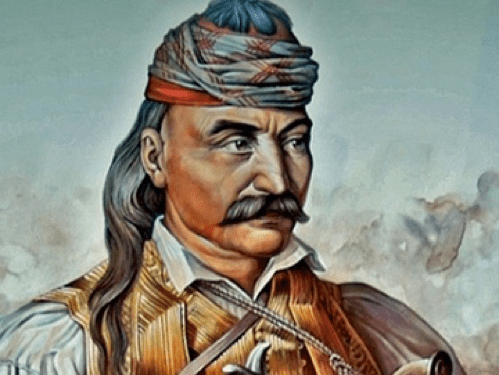
1823 – The Greek civil wars
As history has shown many times over, Greeks always seem to quarrel amongst themselves and the Greek War of Independence was no different. The Greek civil wars between 1823-1825 involved the Roumeliotes (Greeks of Central Greece) and the Greek island shipowners (predominantly from Hydra), against the Peloponnesians.
Many Greek politicians were growing weary of Theodoros Kolokotronis’ influence and control in the region. The provisional government decided that the National Assembly would take place in Nafplio, and asked Kolokotronis to return the fort to the government. Kolokotronis refused, and proposed that the Assembly take place in Nafplion, while the city remained under his control. This was one of the triggers for the Greek civil wars.
1824 – The death of Lord Byron and the destruction of Psara
Lord Byron, a British poet and philhellene who had joined the Greek War of Independence, and Mavrokordatos planned to attack the Ottoman-held fortress of Lepanto (Nafkaktos), at the mouth of the Gulf of Corinth. Before the attack could commence, Byron fell ill on 15 February, 1824, and bloodletting treatment weakened him further. After initially appearing to recover, he later contracted a violent fever and died in Missolonghi on 19 April, 1824. The death of Lord Byron was yet another event in the Greek War of Independence timeline that drew international attention and sympathy for the Greek cause.
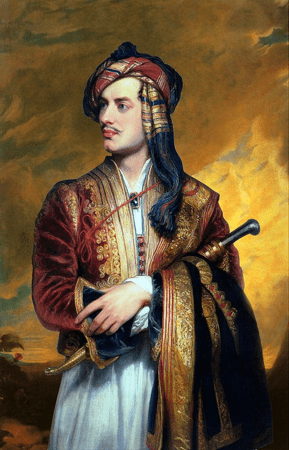
On 5 July, 1824, the Ottomans massacred the civilian population on the Greek island of Psara. Prior to the massacre, the population of Psara was about 7,000. After the massacre, the population of the island never rose over 1,000. This was another devastating event in the Greek War of Independence timeline.
1825 – The death of Papaflessas
The Ottoman Egyption army of Ibrahim Pasha landed in Methoni on February 26, 1825 with 4,400 men and took over the city’s castle, with the aim of recapturing all of the Peloponnese. After receiving reinforcements of a further 15,000 men, he also recaptured the castles of Koroni and Pylos (Neokastro). On 20 May, 1825, Papaflessas led a force of 3,000 Greek revolutionary fighters to attack the Ottoman Egyptians. Upon seeing the size of Ibrahim Pasha’s army, half of Papaflessas’ army fled. The battle led to 1,000 Greek revolutionary fighters losing their life, including Papflessas himself.
The Ottomomans placed the head and body of Papaflessas upright on a post, as a mark of respect for a valiant foe. Legend has it that Ibrahim Pasha even kissed Papaflessas’ head and said “If all Greeks were like him, I would not take charge of this campaign.”
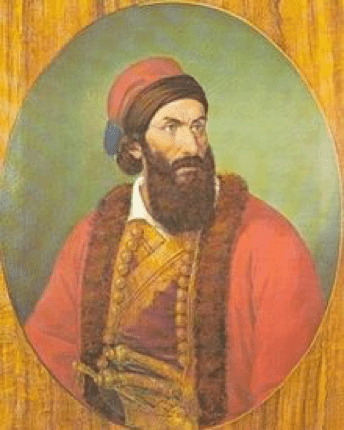
Ibrahim Pasha recaptured Tripolitsa on 7 June, 1825 and then sent an army to recapture Nafplion, the seat of the Greek government. On 13 June, 1825, Captain Yannis Makriyannis, Demetrios Ypsilantis, Andreas Metaxas, and Konstantinos Mavromichalis miraculously defeated the 5,000 strong Ottoman Egyptians with a mere 500 men. A significant victory in the Greek War of Independence timeline and the first victory of Ibrahim Pasha.
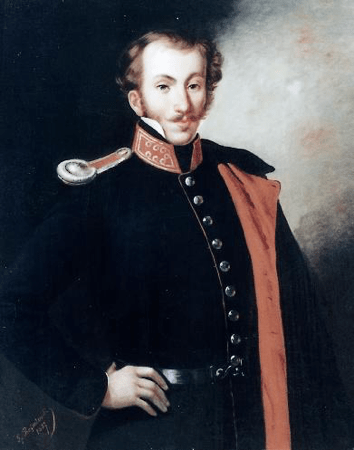
1826 – The exodus of Missolonghi
After two failed attempts to retake Missolonghi, the Sultan sent a message to Reshid Mehmed Pasha: “Either Missolonghi falls or your head falls.” The defence of the fortified city was led by Notis Botsaris, Kitsos Tzavellas, Athanasios Razi-Kotsikas, and Nikolaos Kasomoulis with an army of about 3,000 men. The siege lasted an entire year, and Ibrahim Pasha even joined after the first few months.
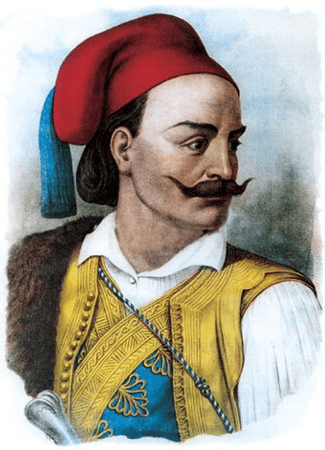
While the Ottoman siege was unsuccessful in breaching the fortress, it did achieve success in cutting off supplies and starving the Greek civilians. The Greek revolutionary captains decided to lead as many civilians as possible to a heroic exodus. Approximately 7,000 Greeks attempted to escape, while only 1,000 made it to safety. The remaining civilians and revolutionaries stayed and defended the city to the death. In yet another brutal act, the Ottomans displayed 3,000 Greek severed heads on the walls of the city.
This horrific event in the Greek War of Independence timeline influenced Britain, France, and Russia to eventually intervene in the Greek revolution.
The same year, Ottoman troops prepared to recapture a large part of Roumeli (Central Greece). Georgios Karaiskakis however, prepared a surprise attack near the village of Arachova. On 18 November, 1826, 2,000 Ottoman soldiers were halted in Arachova by Karaiskaki with a force of 800 men. On 24 November, 1826, the Ottomans attempted to fight their way out. Most were killed in the fighting or died from the harsh cold weather. The Greek victory at Arachova was an event in the Greek War of Independence timeline that established Georgios Karaiskakis as a key figure of the revolution.
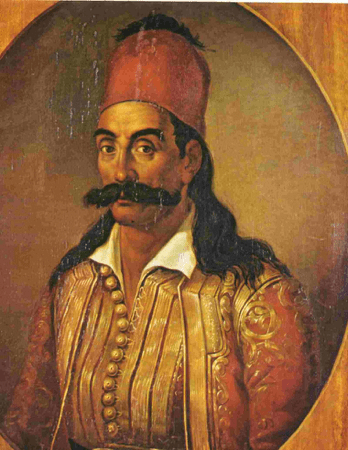
1827 – The new Governor of Greece and the Battle of Navarino
As the highest regarded Greek-born politician in Europe at the time, the National Assembly of Trizina elected Ioannis Kapodistrias Governor of the newly established Greek state on 30 March, 1827.
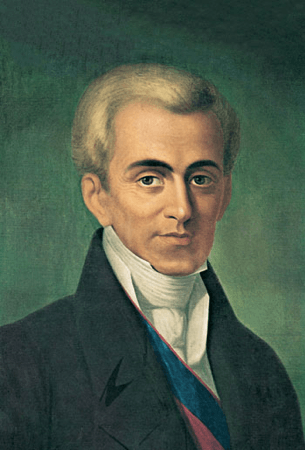
On 20 October, 1827, British, French and Russian warships entered the harbour of Navarino Bay on the west coast of the Peloponnese. At the battle, the Allied forces virtually destroyed the entire Ottoman fleet, which included warships from Egypt and Tunis. This was both a significant event in the Greek War of Independence timeline but also in naval history as it was the last major naval battle fought entirely with sailing ships.
1828 – Ioannis Kapodistrias arrives in Greece and Russia declares war on Turkey
After securing support from the Great Powers, Ioannis Kapodistrias arrived in Nafplio on 7 January, 1828 and was welcomed by most with celebrations and optimism.
Find out more about Ioannis Kapodistrias.
The same year, in retaliation for the Battle of Navarino, the Ottoman Sultan Mahmud II closed the Dardanelles to Russian ships and revoked the 1826 Akkerman Convention. This act, along with the other events of the Greek War of Independence was enough for the Russians to declare war on Turkey on 26 April, 1828 – sparking yet another Russo-Turkish War. Greeks welcomed the war as the Ottoman troops left Greece to fight the Russians.
1831 – The assassination of Ioannis Kapodistrias
In 1831, Ioannis Kapodistrias ordered the arrest and imprisonment of one of the leaders of the revolution – Petros Mavromichalis. Petros’ brother Konstantis and son Georgios Mavromichalis sought revenge and on September 27, Kapodistrias was assassinated in front of the church of Saint Spyridon in Nafplion.
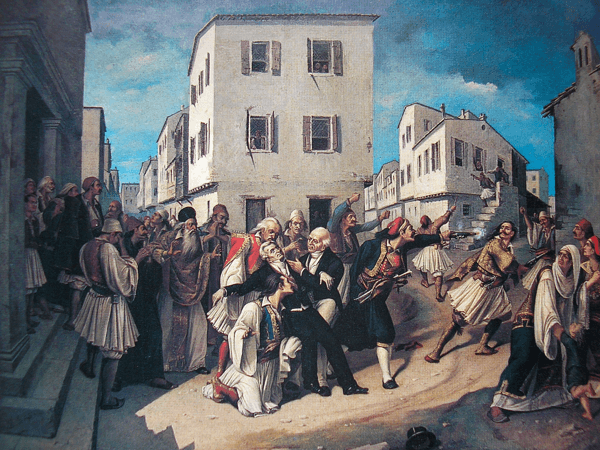
1832 – The Treaty of London & first internationally recognised modern Greek state
Following the assassination of Ioannis Kapodistrias, the Great Powers officially recognised Greece’s independence and installed Otto of Bavaria as the new King of Greece. This was enacted by Britain, France, and Russia who signed the Treaty of London.
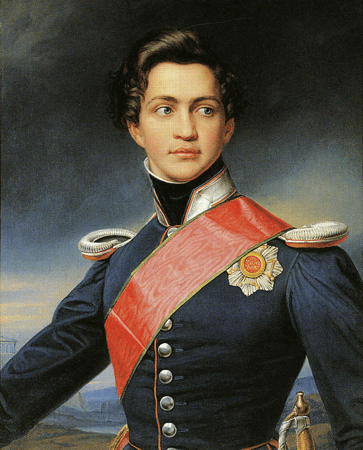
Do you have an ancestral connection to the heroes of the Greek War of Independence? Trace your ancestry to find out. There are a number of DNA tests available but the most common and most trusted of them all is Ancestry.com
